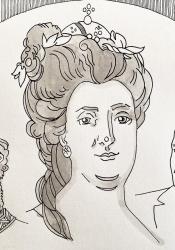Russian Empire First Acquires Ukraine
Ukraine’s first connection to Russian imperialism and colonialism dates all the way back to the rule of Catherine the Great and the height of the Russian Empire’s power. During the 18th century, Russia was slowly but surely working its way west, starting wars and taking over as much territory as it could. Although Catherine the Great put on the persona of an enlightened leader whose utmost goal was to bring Russia to glory, her actions towards the peoples of Eastern Europe – those who she so desperately wanted as a part of that empirical glory – were not so honorable. It was she who took charge of expanding Russian territory, stretching her country’s borders even further to encompass what is now modern-day Ukraine. The inhabitants of that land, however, which was considered a part of Poland at this point, did not appreciate or welcome their forced subjugation by the Russians, so they began to rebel, rioting and fighting back against their oncoming forces. Unswayed by these acts of defiance, Catherine proved her fierce determination for Russian expansion by quelling the rebellion, stretching out her mighty hand and crushing anyone who would dare to defy her rule and upset her plan for her empire. Whether the motivation behind this conflict was to further Catherine’s colonial ambitions or to secure Russia’s borders, the events that transpired set the stage for a continued hostility between the territories (Smilyanskaya).
In the official Declaration of the end of the war, the Polish territory was clearly divided between the Austrian monarchy and Queen Catherine, saying: “All the lands, possessions, cities, towns and villages contained in the above line, will be attached forever to the Russian Empire and a calm and undeniable possession will be hers and will be guaranteed to her in a reliable and solemn manner” (Cobenzel). In their minds, this was the new, permanent reality; Ukrainian lands would become Russia’s and there would be no more protests, no more uprisings. According to these official war documents, it appears that Catherine genuinely believed she was doing the Ukrainian people a favor, taking them under her powerful wing and bringing them into her protection. What she failed to consider though, was that perhaps her empire was the very thing the Ukrainian people desired protection from the most, but the damage had already been done. “From then to now, Russia is following a copybook pattern of confrontation with the West” (Maitra); this Russian aggression was merely the first example of a long line of antagonistic behavior that continues to this day.
Just like Catherine, Russia’s current leader Vladimir Putin has seemed to believe that his actions towards Ukraine have been in its best interest, spreading the mindset that Ukraine would be better off under Russian control; that there is little hope they would be able to survive and thrive on their own. Seeing how Ukraine has been treated down through the years – by Catherine over 250 years ago and now Putin today – it is no wonder that the Ukrainian people are tired of Russia meddling in their affairs, of dictating how they should run their own country.
Works Cited
Cobenzel, Count Ludwig. “Declaration of Russia and Austria on the Third Partition of Poland.” 1794, www.hrono.info/dokum/1700dok/1794polon.php
Maitra, Dr. Sumantra. “Catherine the Great to Vladimir the Cunning: The Ever Present Realism in Russian Foreign Policy.” 1 Sep 2014. SSRN, www.papers.ssrn.com/sol3/papers.cfm?abstract_id=2489502
“Prince Vladimir of Kiev, Catherine the Great, and Vladimir Putin.” 2022. Russian Life, www.russianlife.com/stories/online/ukraine-invasions-and-justifications-catherine-the-great-got-there-first/
Smilyanskaya, Elena. “Russian Warriors in the Land of Militates and Themistocles: The Colonial Ambitions of Catherine the Great in the Mediterranean.” 13 May 2014. HSE Working Papers, www.papers.ssrn.com/sol3/papers.cfm?abstract_id=2436332

